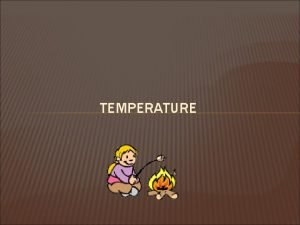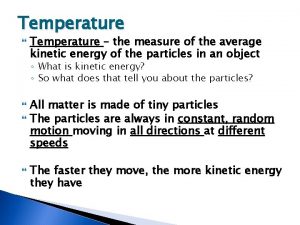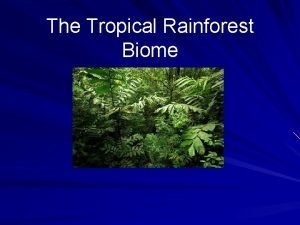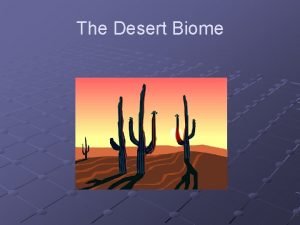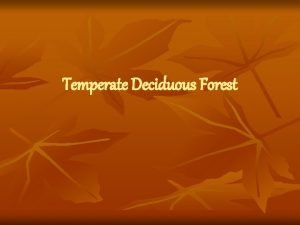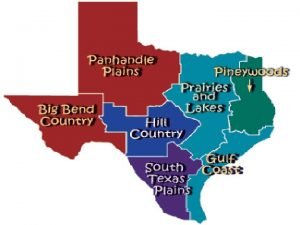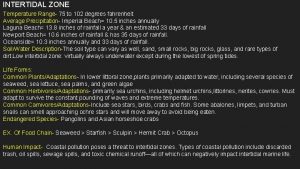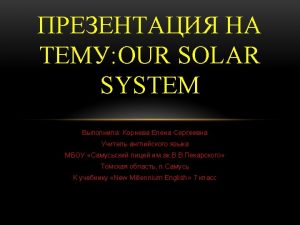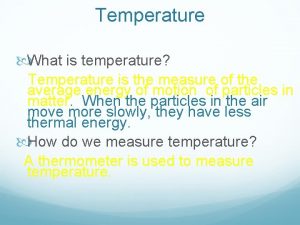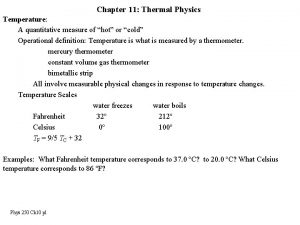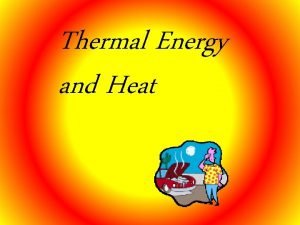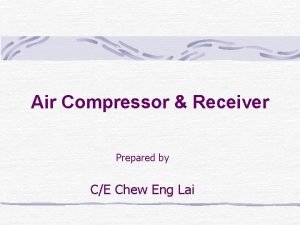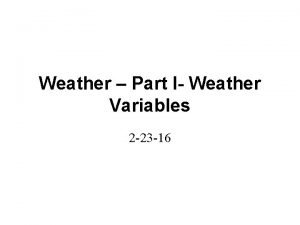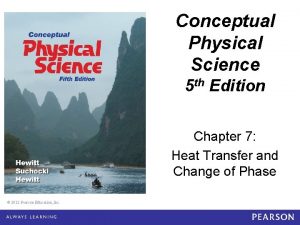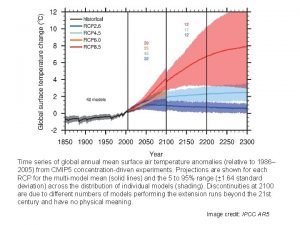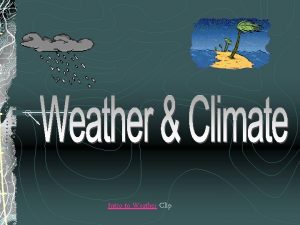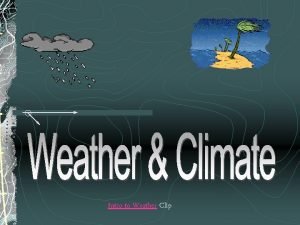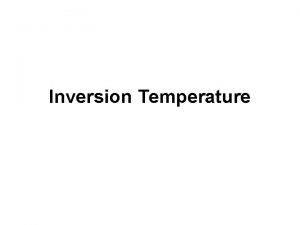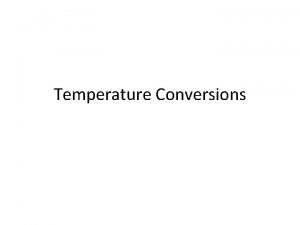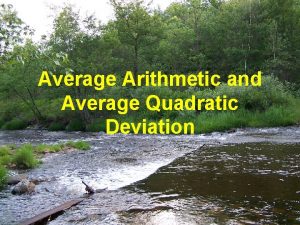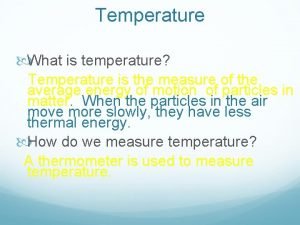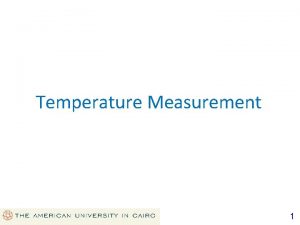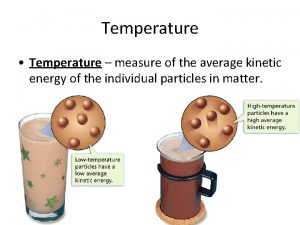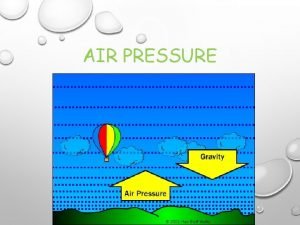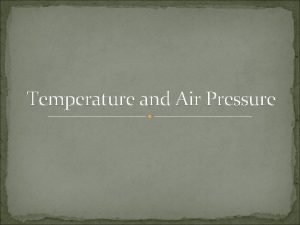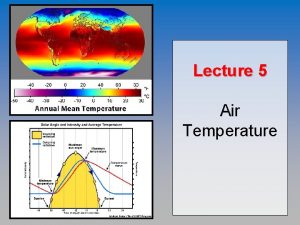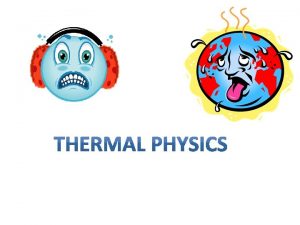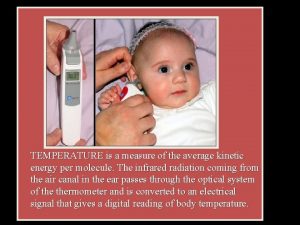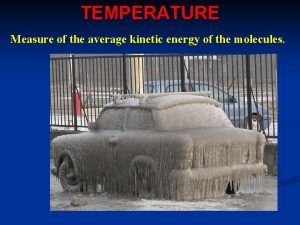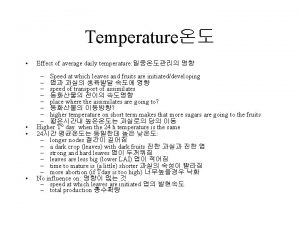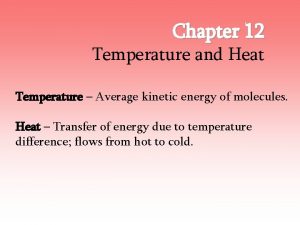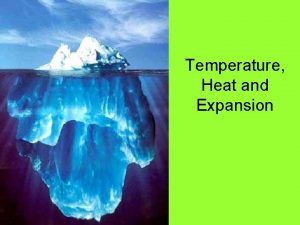Air Temperature Temperature a measure of the average




























- Slides: 28

Air Temperature

►Temperature : § a measure of the average speed at which molecules are moving or vibrating.

►Air temperature § the rate of motion of gas molecules in the atmosphere as a result of the absorption of energy § measured by a thermometer

Temperature scales ► Celsius § water freezes at 0 o § water boils at 100 o ► Fahrenheit § water freezes at 32 o § water boils at 212 o ► Kelvin § no molecular motion at 0 K § water freezes at 273 K § water boils at 373 K

Conversions F = (1. 8 x o. C) + 32 ►o C = 0. 56 (o. F - 32) ►o ►K = o. C + 273

What determines the temperature of a place? 1. Insolation (daily and annual cycles) 2. Latitude 3. Urban/Rural Surface 4. Coastal vs. Interior location 5. Elevation

1. Insolation A. Changing angle of noon sun throughout the year changes temperature on a seasonal basis.



►Why temperature difference between equinoxes?

Spring : at end of cold, short day period ► § more energy loss ►Autumn : at end of day period § more energy gain warm, long

1. Insolation B. Changing angle of sun throughout the day changes temperature on a daily basis.



►lag between max insolation and max temperature § because highest temp at time of max ABSORBED insolation

2. Latitude ► Higher latitudes receive less insolation than lower latitudes § sun’s rays are more oblique § daylength is variable § Net energy surplus in tropics; net energy deficit in polar regions

3. Urban/rural Surface ► Evapotranspiration differences ► Urban impervious surfaces ► Urban highly absorbent (low albedo) surfaces ► Urban fuel consumption and excess heat ► “Urban heat island”

4. Coastal vs. interior locations ►Water bodies have a moderating effect on temperature.


► “Land heats up and cools down more rapidly than water. ” § Therefore: ►Coastal: smaller temperature ranges than continental locations. ►Coastal locations have their maximum temperatures well after maximum insolation.




►Lake effect in Duluth is an example of changes in temperature due to being close to a large body of water.

5. Altitude / Elevation ►Temperature decreases as elevation increases. § less mass, less pressure, less absorption


Exception: temperature inversion

►Conditions favorable for a temperature inversion: § cool, clear, calm night
 Measure air temperature and measure air pressure
Measure air temperature and measure air pressure Temperature is a measure of the average:
Temperature is a measure of the average: The measure of average kinetic energy is called
The measure of average kinetic energy is called Temperature is a measure of the average
Temperature is a measure of the average Air higroskopis adalah
Air higroskopis adalah Differentiate between average speed and average velocity
Differentiate between average speed and average velocity Quantile range
Quantile range Is measure for measure a comedy
Is measure for measure a comedy What is the average temperature in a tropical rainforest
What is the average temperature in a tropical rainforest Taiga ecosystem food chain
Taiga ecosystem food chain Cold deserts map
Cold deserts map Where are temperate deciduous forest located
Where are temperate deciduous forest located Llano uplift rainfall
Llano uplift rainfall Intertidal zone average temperature
Intertidal zone average temperature Clifden ireland average temperature
Clifden ireland average temperature Diameter of the mercury
Diameter of the mercury What does temperature measure
What does temperature measure Is temperature a quantitative measure of heat
Is temperature a quantitative measure of heat Q=mct
Q=mct Bursting disc in air compressor
Bursting disc in air compressor Which instrument is used to measure air pressure
Which instrument is used to measure air pressure Difference between curie temperature and neel temperature
Difference between curie temperature and neel temperature Difference between curie temperature and neel temperature
Difference between curie temperature and neel temperature Ferromagnetis
Ferromagnetis Humidity brainpop
Humidity brainpop Conceptual physical science 5th edition
Conceptual physical science 5th edition Global mean surface air temperature
Global mean surface air temperature Brain pop weather
Brain pop weather Brainpop weather
Brainpop weather

